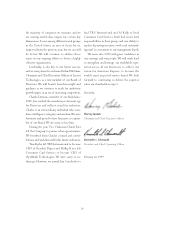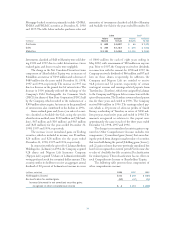American Express 1998 Annual Report Download - page 32
Download and view the complete annual report
Please find page 32 of the 1998 American Express annual report below. You can navigate through the pages in the report by either clicking on the pages listed below, or by using the keyword search tool below to find specific information within the annual report.
was no parent company commercial paper outstanding dur-
ing 1998 or 1997.
Total parent company long-term debt outstanding was
$1.1 billion at December 31, 1998 and 1997. At December
31, 1998 and 1997, the parent company had $2,050 mil-
lion and $550 million, respectively, of debt or equity
securities available for issuance under shelf registrations filed
with the Securities and Exchange Commission. In addition,
TRS, Centurion Bank, Credco, American Express Overseas
Credit Corporation Limited and AEB have established pro-
grams for the issuance, outside the United States, of debt
instruments to be listed on the Luxembourg Stock
Exchange. The maximum aggregate principal amount of
debt instruments outstanding at any one time under the
program will not exceed $3 billion. At December 31, 1998
and 1997, $1.1 billion of debt has been issued under this
program. In January 1999, an additional $500 million of
debt was issued under this program.
In July 1998, American Express Company Capital
Trust I, a wholly-owned subsidiary of the Company, estab-
lished as a Delaware statutory business trust (the Trust),
completed a public offering of 20 million shares (carrying
value of $500 million) of 7.0% Cumulative Quarterly
Income Preferred Shares Series I (liquidation preference
of $25 per share). Proceeds of the issue, which represent
the sole assets of the Trust, were invested in Junior
Subordinated Debentures (the Debentures) issued by the
Company, due 2028. The Company used the proceeds
from the Debentures for general corporate purposes. See
Note 5 to the Consolidated Financial Statements for fur-
ther information.
RISK MANAGEMENT
Management establishes and oversees implementation of
Board-approved policies covering the Company’s funding,
investments and use of derivative financial instruments and
monitors aggregate risk exposures on an ongoing basis.
The Company’s objective is to realize returns commen-
surate with the level of risk assumed while achieving
consistent earnings growth. Individual business segments
are responsible for managing their respective exposures
within the context of Board-approved policies. See
Note 7 to the Consolidated Financial Statements for a
discussion of the Company’s use of derivatives.
The following sections include sensitivity analyses of
three different tests of market risk and estimate the effects
of hypothetical sudden and sustained changes in the applic-
able market conditions on the ensuing year’s earnings, based
on year-end positions. The market changes, assumed to occur
as of year end, are a 100 basis point increase in market inter-
est rates, a 10% strengthening of the U.S. dollar versus all
other currencies, and a 10% decline in the value of equity
securities under management at AEFA. Computations of the
prospective effects of hypothetical interest rate, foreign
exchange rate and equity market changes are based on numer-
ous assumptions, including relative levels of market interest
rates, foreign exchange rates and equity prices, as well as the
levels of assets and liabilities. The hypothetical changes and
assumptions will be different from what actually occurs in
the future. Furthermore, the computations do not anticipate
actions that may be taken by management if the hypotheti-
cal market changes actually occur over time. As a result,
actual earnings effects in the future will differ from those
quantified below.
TRS’ hedging policies are established, maintained
and monitored by a central treasury function. TRS generally
manages its exposures along product lines. A variety of
interest rate and foreign exchange hedging strategies are
employed to manage interest rate and foreign currency risks.
For Charge Card products, TRS funds its Cardmember
receivables using both on-balance sheet sources, such as
long-term debt, medium-term notes, commercial paper and
other debt, and an asset securitization program. Such
funding is predominantly obtained by Credco and its sub-
sidiaries. Interest rate exposure is managed through the
issuance of long- and short-term debt and the use of inter-
est rate swaps to achieve a targeted mix of fixed and floating
rate funding. During 1998 and 1997, TRS targeted this mix
to be approximately 100 percent floating rate. In early 1998,
TRS purchased interest rate caps to limit the adverse effect
of an interest rate increase on substantially all Charge Card
funding costs. The majority of these caps matured during
1998. In 1999, TRS is entering into a series of interest rate
swaps to convert a majority of its funding from floating rate
to fixed rate. It is anticipated that this process will be com-
pleted by the end of the first quarter of 1999.
For its lending products, TRS funds its Cardmember
loans using a mixture of long- and short-term debt, and an
asset securitization program, primarily through Centurion
Bank. The interest rates on TRS’ lending products are gen-
erally linked to a floating rate base and typically reprice each
month. Centurion Bank generally swaps its fixed-term debt,
paying rates that reprice similarly with changes in the base
rate of the underlying loans.
The detrimental effect on TRS pretax earnings of a
hypothetical 100 basis point increase in interest rates would
be approximately $170 million and $169 million, based on
1998 and 1997 year-end positions, respectively. This effect
is primarily due to the variable rate funding of the Charge
Card products. Had the series of swaps purchased in early
1999 been in effect at December 31, 1998, the 1998 effect
would have been substantially lower. Similarly, had the inter-
est rate caps purchased in early 1998 been in effect at
December 31, 1997, the 1997 effect would be reduced by
nearly half.
TRS’ foreign exchange risk arising from cross-
currency charges and balance sheet exposures is managed
primarily by entering into agreements to buy and sell cur-
rencies on a spot or forward basis. In the latter part of 1998
and 1997, foreign currency forward contracts were both
sold ($569 million and $562 million, respectively) and pur-
chased ($34 million and $92 million, respectively) to
manage a majority of anticipated cash flows in major over-
seas markets for the subsequent year.
30
























